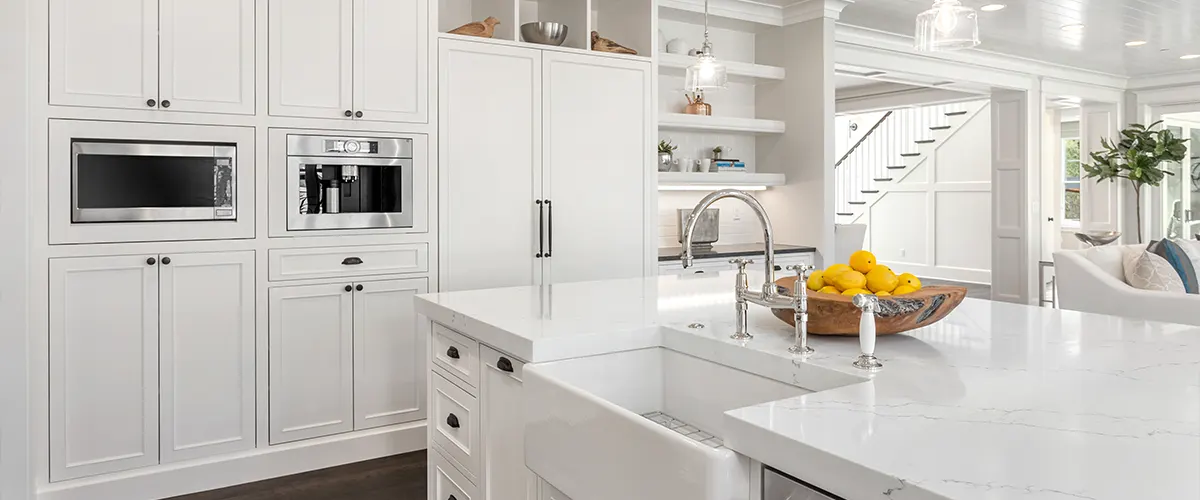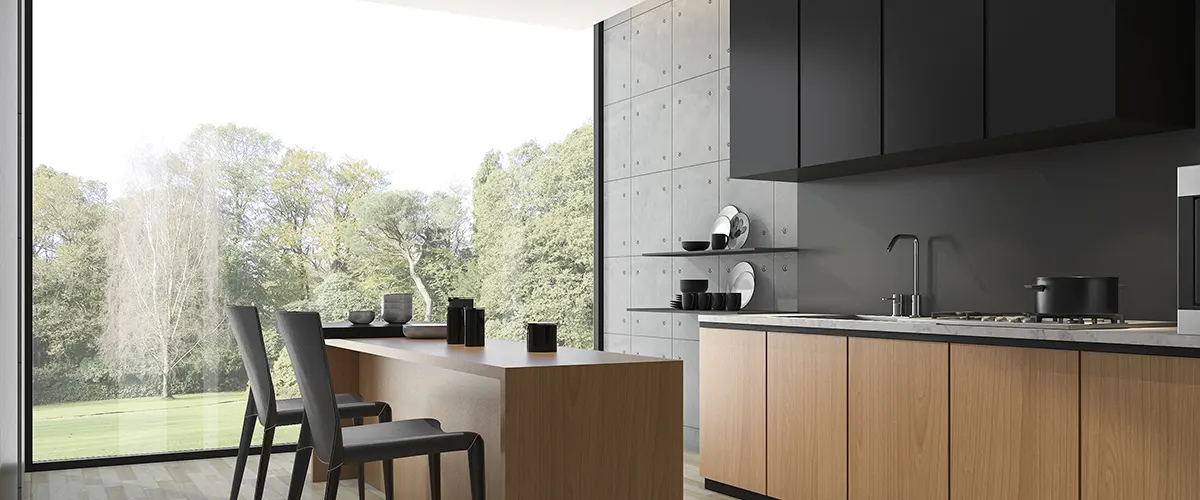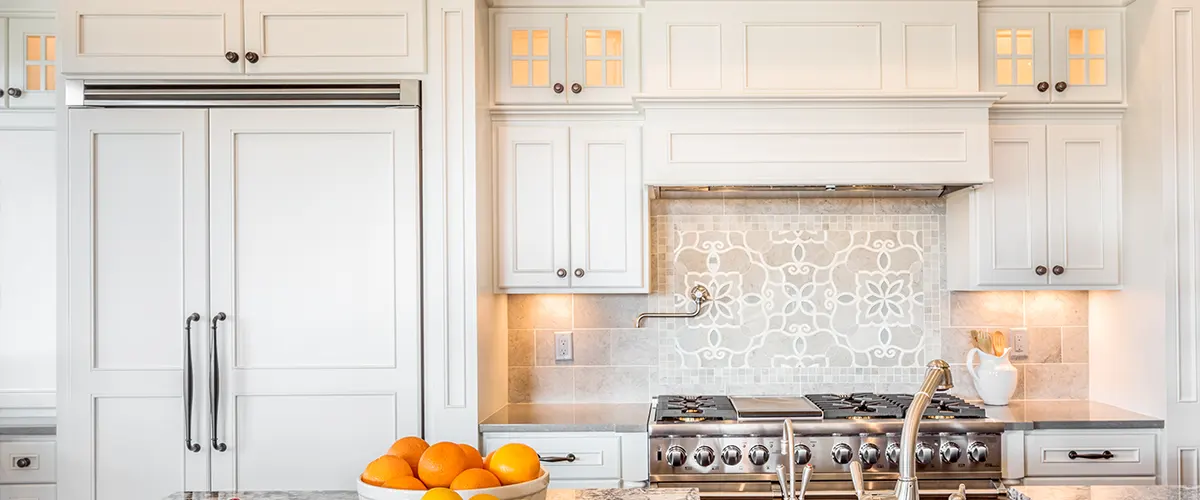Homeowners are constantly looking for ways to update their kitchens without spending a fortune.
One of the most affordable ways to do it is by refinishing kitchen cabinets to give your space a new and better look.
In this blog post, you’ll discover the easiest process of refinishing your kitchen cabinets step-by-step. And even if a DIY refinishing is no match for a professional cabinet refinish, we’ll share some great tips that might help you out.
Let’s get started!

Refinishing vs. Refacing vs. Replacing Cabinets
Let’s see the difference between the three main options you have when it comes to upgrading your kitchen cabinets.
- Refinishing a cabinet means removing the old paint or stain by sanding its surface or using a chemical remover. Kitchen cabinet refinishing is better than refacing or replacing them altogether because it's more affordable and less time-consuming. When refinishing kitchen cabinets, you're not changing their doors or box. However, it's up to you if you want to replace your cabinets' hardware. As a rule of thumb, cabinet painters charge about $90 per hour.
- Refacing a cabinet implies changing the cabinet skin panels to give it an entirely new look. It's a more costly endeavor than refinishing them, but still a more affordable option than replacing them altogether. When refacing kitchen cabinets, update the hardware too if you want to match the new style. The national average cost to reface cabinets is $6,518.
- Replacing your kitchen cabinets is one of the most expensive kitchen upgrades, but one worth every penny. New kitchen cabinets bring a fresh vibe to any space and can quickly become the focal point of your kitchen. If you don't want to break the bank with custom cabinets, semi-custom or stock cabinets will bring similar results at a lower price. According to Manta, homeowners in Johnson County pay for cabinet installation an average of $10,233.

What To Know Before You Start Refinishing Kitchen Cabinets
Before you start painting your kitchen cabinets, it’s important to take protective measures to ensure that your cabinets are well-protected and won’t be damaged.
Here are a few tips for protecting your kitchen cabinets before you start painting:
- Remove all hardware from the cabinets, such as door handles, knobs, and hinges.
- Wrap all hardware in plastic wrap and tape it securely in place.
- Cover all countertops and appliances in the kitchen with plastic sheeting.
- Protect the flooring with a drop cloth or painter's tape.
- Close all kitchen cabinet doors and use painter's tape to cover the seams.
- Cover any windows in the kitchen with paper, taping along the top and sides of sashes to prevent overspray from seeping behind the covering.
When working with paint and chemical removers, wear protective gear like eyewear, gloves, long sleeves, pants, etc. These chemicals are harmful if they come in contact with your skin or eyes.
When repainting kitchen cabinets by spraying paint, it’s best to use a breathing mask too. Check out the 2022 Cost Of Painting Kitchen Cabinets!

The Process Of Refinishing Kitchen Cabinets
1. Polish The Surface Until It's Smooth And Ready To Paint
Polish the surface of your cabinets to remove any dirt, debris, or food residue. This helps you see if there are any cracks and fix any visible chips. Make sure to use a clean, lint-free towel to polish the surface.
Lightly sand all the doors of your cabinets down to get rid of the old paint and help your primer stick better.
If you’re not looking to get dirty or don’t want to risk damaging your cabinets, your local experts from Mortise & Miter will make your cabinets look brand new with the best refinish in town.
2. Use a degreaser before refinishing Kitchen Cabinets
After you finish polishing your cabinets, it’s time to clean them thoroughly.
Paint sticks better to clean surfaces, and it helps avoid any peeling or bubbling.
You can mix warm water and dish soap and use a smooth sponge to clean the cabinets. A degreaser is also a great choice, considering your kitchen cabinets are subject to grease and many spills.
Don’t use bleach to clean your kitchen cabinets, as it can hurt both the wood and cause the paint to peel off.
Rinse well with clean water and let dry completely before painting.
3. Apply One Coat Of Primer For A Smooth Finish
Use a paint sprayer to apply the primer to your kitchen cabinets. Primer makes the paint stick better, so make sure you cover all surfaces of the cabinets, including any trim or molding.
Read the instructions on the product and give your primer enough time to dry before applying the first coat of paint. A good rule of thumb is to wait about 20-30 minutes before you start painting.
4. Apply the first coat of paint
After the surface has dried, get your paint roller, brushes, or pump spray and start refinishing your cabinets.
While you wait for the second coat of paint, make sure your cabinet boxes, cabinet frames, and face frames don’t need an update too.
We recommend sticking with a light or neutral color to avoid overwhelming your kitchen.
If you’re using a darker color, it might be good to apply a coat of sealer over the top to help protect the paint from scratches and wear and tear.
Neutral colors are great for cabinets because they keep your kitchen timeless, and they are easy to match with other colors.

Refinishing Kitchen Cabinets Made Of Wood
Paint doesn’t stick well to solid wood, so you’ll have to refinish your wooden kitchen cabinets by staining them. When staining cabinets, there are a few things you need to keep in mind.
There are various stains available on the market, so it’s important to find one that matches the look you’re going for. The steps to cleaning your cabinets are the same as when painting them, except you don’t need a primer.
Once you’ve chosen the right stain, apply it in even strokes with your best brush. Be sure to apply it in the same direction as the wood grain and cover all surfaces.
To properly refinish wood cabinets, apply a coat of sealant after the stain has dried. A sealer protects your cabinets from wear and tear and will also help keep them looking good for longer.
If you’re interested in more ways to update your kitchen cabinets, other than refinishing them, discover some Easy Ways To Update Your Kitchen Cabinets!
Frequently Asked Questions
Conclusion
Refinishing is the best choice if you have cabinets with faded and outdated paint. Refinishing kitchen cabinets makes your kitchen seem newer and increases this room’s value.
Refinishing is great because you can do it without moving any furniture or appliances. All you’ll need to do is make sure everything’s covered!
However, you may want an expert to refinish kitchen cabinets with minimal hassle and maximum results (and who wouldn’t?). We offer professional kitchen remodel, bathroom remodel, and basement remodel for homeowners all around Johnson County – Overland Park, Olathe, Lenexa, and more of Kansas City.
Let our professionals from Mortise & Miter get you the most cost-effective solution for your kitchen upgrade. Call us today at (913) 214-6211 and let’s discuss your project, or get in touch today by requesting a quote.
Let’s transform your cabinets together!


